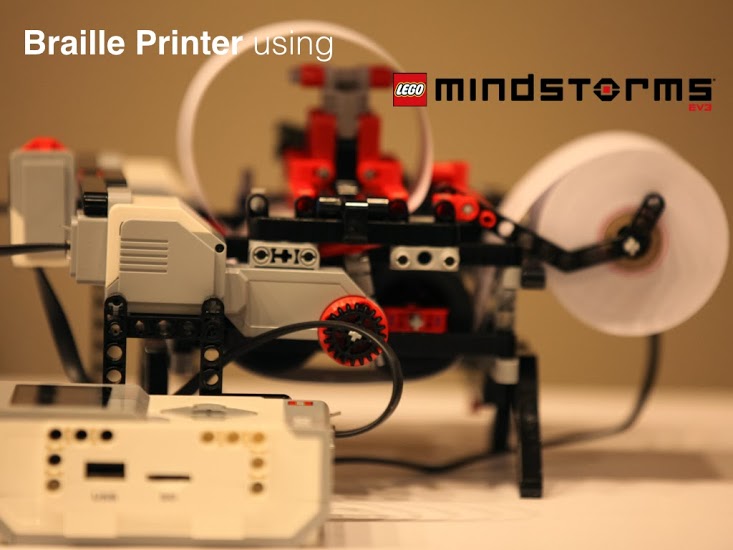Accessibility devices tend to be prohibitively expensive, and it’s always nice to see a hacker apply their skills to making these devices more affordable. BRAIGO is a low cost braille printer by [Shubham Banerjee]. He built the printer using parts from the LEGO Mindstorms EV3 kit, with a few additions. This LEGO kit retails for $349, and a standard braille printer costs over $2000.
The BRAIGO print head uses weights and a pin to punch holes in standard calculator paper rolls. LEGO motors are used to feed the paper and align the head for accurate printing. It takes about 5 to 7 seconds to print each letter, which are entered on the Mindstorms controller.
While this is a great prototype, [Shubham] intends to continue development with the goal of creating an affordable braille printer. He’s a bit swamped with media requests right now, but is working on releasing BRAIGO as an open source project so others can contribute. It’s an impressive project, especially for a 12 year old student. After the break, watch the BRAIGO do some printing.
Another Open Source braille related project we saw several years ago pipes digital chars to an Arduino powered braille terminal.

















My mother was a certified Braille transcriber. She taught me that Braille is not just the conversion of letters into six-bit cells. Frequently used words are shortened, abbreviations are common and short sequences of characters (cells) are used extensively for all sorts of layout and punctuation stuff. Just like Morse Code, abbreviations and shortcuts are used to increase the information content of a page.
Engineers call that “compression”.
Many people call that “spelling”.
It’s just a system of shorthand, like any other.
No “yoj”
A much nicer Lego braille machine, imo, here: http://www.youtube.com/watch?v=RKNkLH8PNZI
Can you use this to explain to blind people what’s happening in the lego movie?
They are prohibitively expensive because they are charged to medicare, who doesnt bat an eye for the 20x markup of 70’s technology.
Braille printers aren’t charged to MediCare, sorry. That’s just incorrect. There is some government funding for assistive technology equipment, but it’s not through MediCare.
Most braille embossers have been recently updated or were developed within the last decade. There are new technologies combining black or even color ink print with braille and with tactile graphics, and there are new embossing technologies being researched and implemented into new products. Yes, there are a few products which have basically been the same since the 80s. But if you actually do some research on embossers, you’ll find that most technologies are new.
Modern assistive technology is expensive because it’s expensive to build. Components in a braille embosser have to be very precise in order to create readable braille. The cost to develop these products is very high, and despite what you may think, profits are pretty low. The companies that manufacture embossers are small and most dump any profits they make into developing new technologies or improving their existing ones, not to mention paying employees to support the software necessary to use the machines and the users who are actually working with them.
Why does a 2000-pound Lotus Elise cost so much more than a 2000-pound Honda Fit?
Why does an oil painting cost more than a poster?
Braille printers are prohibitively expensive because of the small production volumes in a specialized market. Every single part is custom-made. R&D and tooling costs are spread over a small number of units.
Do the math, of course they’re expensive.
3D printer is ideal for small runs of custom parts. 3D printer prices have dropped such as hobbyists are not using them. US govt is scared someone will make a plastic gun undetectable w/ 3D printer. So there has to be something here. An embedded all in one board would do the trick for abbrev. etc. customizable with SSD storage for language customization too.
Somebody give that kid a scholarship!
I saw a similar device at a Makerfaire last year. It used Dymo labelling tape (which of course can be embossed easily). Three servo motors with small punches attached were arranged so that they would emboss the three vertical dots in a Braille character cell. Another motor with a rubber wheel attached would move the Dymo tape through the machine. To make a character the device would emboss the three dots on the left, using the servos to press the punches into the tape, then the motor would advance the tape by half a cell-width so that the dots on the right of the cell could be punched. Then the motor advanced to the next cell position.
It didn’t use Lego, but it might have used an Arduino…